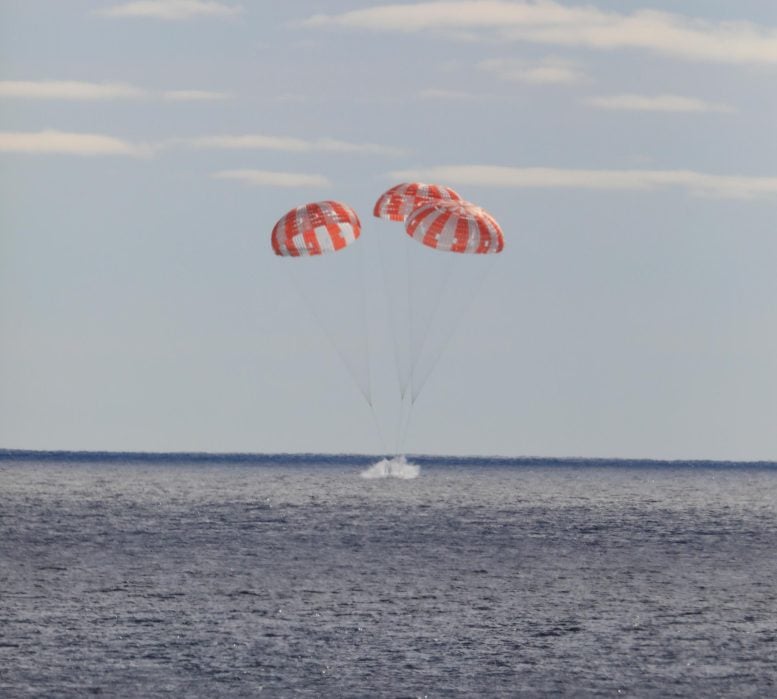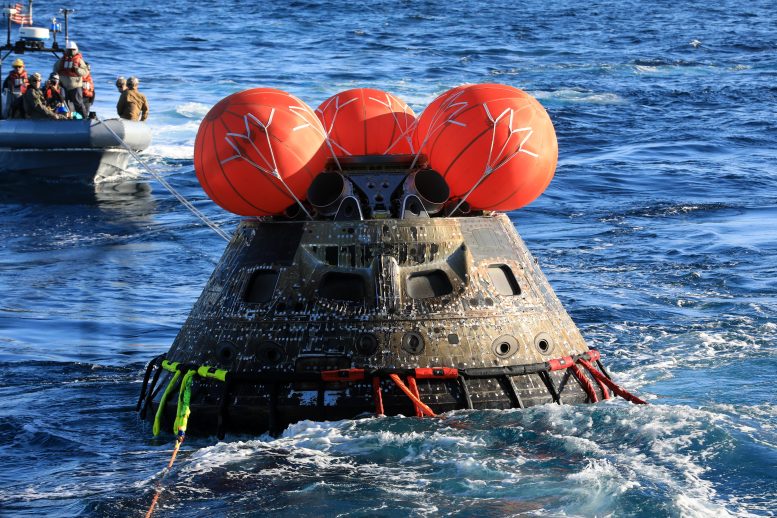At 12:40 p.m. EST, December 11, 2022, NASA’s Orion spacecraft for the Artemis I mission splashed down in the Pacific Ocean after a 25.5 day mission to the Moon. Orion will be recovered by NASA’s Landing and Recovery team, U.S. Navy and Department of Defense partners aboard the USS Portland. Credit: NASA At the direction of the NASA recovery director, Navy divers and other team members in several inflatable boats approached the spacecraft. When Orion was ready to be pulled into the ship’s well deck at the waterline, the divers attached a cable, called the winch line, to pull the spacecraft into the ship and up to four additional tending lines to attach points on the crew module. The winch pulled Orion into a specially designed cradle inside the ship’s well deck and the other lines controlled the motion of the spacecraft. Once Orion was positioned above the cradle assembly, technicians drained the well deck and secured it on the cradle. Once aboard the vessel, teams took the spacecraft to U.S. Naval Base San Diego. They will soon return it to NASA’s Kennedy Space Center for inspection. Technicians in Florida will thoroughly inspect Orion, retrieving data recorded on board, removing onboard payloads, and more. At 12:40 p.m. EST, December 11, 2022, NASA’s Orion spacecraft for the Artemis I mission splashed down in the Pacific Ocean after a 25.5 day mission to the Moon. Seen here is NASA’s Landing and Recovery team, U.S. Navy and Department of Defense partners recovering the Orion spacecraft aboard the USS Portland off the coast of California. Credit: NASA Artemis I was the first integrated test of NASA’s deep space exploration systems – the Orion spacecraft, SLS rocket, and the supporting ground systems – and the first in a series of increasingly complex missions at the Moon. Through Artemis missions, NASA will establish a long-term lunar presence for scientific discovery and prepare for human missions to Mars. NASA’s Artemis I mission leaders participate in a news conference following the splashdown of the Orion spacecraft in the Pacific Ocean, west of Baja California, at 9:40 a.m. PST (12:40 p.m. EST) Sunday after a record-breaking mission, traveling more than 1.4 million miles on a path around the Moon and returning safely to Earth, completing the Artemis I flight test. Credit: NASA NASA hosted a post-splashdown news conference (video embedded above). Participants include:
Bill Nelson, NASA administratorJim Free, NASA associate administrator for the Exploration System Development Mission Directorate, NASA HeadquartersVanessa Wyche, director, JohnsonJanet Petro, director, KennedyMike Sarafin, mission manager, NASA HeadquartersHoward Hu, Orion Program manager, JohnsonEmily Nelson, chief flight director, JohnsonMelissa Jones, recovery director, Kennedy

